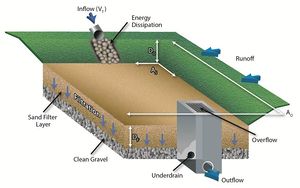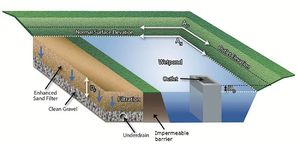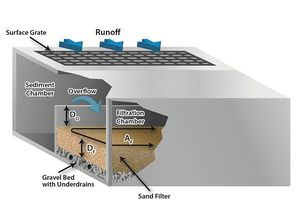
This site is under construction. Anticipated completion date is May, 2015.
Credit refers to the quantity of stormwater or pollutant reduction achieved either by an individual BMP or cumulatively with multiple BMPs. Stormwater credits are a tool for local stormwater authorities who are interested in
- providing incentives to site developers to encourage the preservation of natural areas and the reduction of the volume of stormwater runoff being conveyed to a best management practice (BMP);
- complying with permit requirements, including antidegradation (see [1]; [2]);
- meeting the MIDS performance goal; or
- meeting or complying with water quality objectives, including Total Maximum Daily Load (TMDL) Wasteload Allocations (WLAs).
This page provides a discussion of how sand filter practices can achieve stormwater credits.
Overview
Sand Filters are filtration practices that use sand media to filter and remove pollutants from stormwater before entering the downstream stormwater system or BMP. Enhanced Sand Filters, also known as iron enhanced sand filters or Minnesota Filters, use iron mixed with the filter media to improve removal of dissolved constituents from the stormwater. Common types of sand filters are perimeter filters, surface filters, or underground filters. Enhanced sand filters are commonly implemented as filtration basins, or as filtration benches for wet ponds. Because sand filters are not designed to infiltrate or store stormwater, all filters require use of an underdrain to convey treated stormwater out of the system.
Pollutant Removal Mechanisms
Sand filters primarily remove pollutants through settling and filtration of solids, whereas enhanced sand filters also remove pollutants through chemical binding. Additionally, surface sand filters that incorporate vegetation into the practice will provide biological removal of nutrients via uptake by the vegetation (WEF, Design of Urban Stormwater Controls). While enhanced sand filters are effective in screening solids, the primary water quality benefits they provide are the removal of dissolved constituents including metals and phosphates. Sand filters and enhanced sand filters are not designed to infiltrate and therefore do not provide stormwater volume reduction benefits. See Section 3, Other Pollutants, for a complete list of other pollutants addressed by sand filters and enhanced sand filter practices.
Location in the Treatment Train
Stormwater Treatment Trains are comprised of multiple Best Management Practices that work together to minimize the volume of stormwater runoff, remove pollutants, and reduce the rate of stormwater runoff being discharged to Minnesota wetlands, lakes and streams. Under the Treatment Train approach, stormwater management begins with simple methods that prevent pollution from accumulating on the land surface, followed by methods that minimize the volume of runoff generated and is followed by Best Management Practices that reduce the pollutant concentration and/or volume of stormwater runoff. Sand filters may be used in a treatment sequence as pretreatment for other structural controls, or as a stand-alone BMP.


